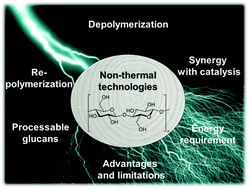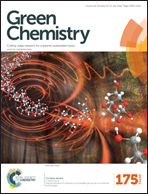Depolymerization of cellulose to processable glucans by non-thermal technologies
Abstract
In this review, we discuss the recent progress made in the field of non-thermal technologies for the selective depolymerization of cellulose to processable glucans. The synergy of these technologies with catalysis, their impact on the cellulose structure and reactivity are discussed. Particularly, we highlight that these non-thermal technologies not only induce a fast cleavage of the β-1,4 glycosidic bond of cellulose but also promote random re-polymerization reactions yielding glucans with different types of glycosidic linkages (α/β-1,4, -1,3, -1,6, -1,2) and degrees of polymerization. Remarkably, these technologies are capable of converting cellulose to soluble glucans at low temperature (<70 °C), a pivotal aspect with respect to sugar stability and purity. Furthermore, the absence of solvent (and catalyst in some cases) greatly facilitates the isolation of glucans. Thanks to the presence of different types of glycosidic linkages, these glucans are much more prone to functionalization or catalytic conversion than cellulose, thus paving the way for the production of macromolecules that have a great market potential. The electricity requirement is one of the main cost drivers for the implementation of these technologies. Based on the market price of a few products, we wish to discuss the application domains of these technologies in terms of the business capabilities it may support. Mechanocatalysis, non-thermal atmospheric plasma and sonochemistry were selected as the main examples for the discussion.


 Please wait while we load your content...
Please wait while we load your content...